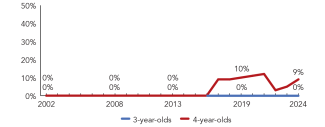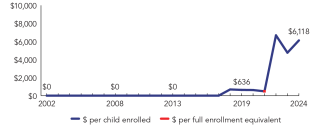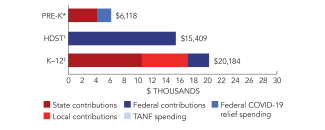
State of Preschool
North Dakota
Access Rankings
Resource Rankings
Total Benchmarks Met
Overview

During the 2023-2024 school year, North Dakota Best in Class enrolled 896 children, an increase of 357 from the prior year. State spending totaled $3,666,515, and an additional $1,815,000 in federal recovery funds supported the program, up $2,919,855 (114%), adjusted for inflation, since last year. Spending per child (including federal recovery dollars) equaled $6,118 in 2023-2024, up $1,365 from 2022-2023, adjusted for inflation. North Dakota met 5 of 10 quality standards benchmarks.
What's New

As of the 2023-2024 school year, lead teachers employed by public and nonpublic schools are now required to have 15 hours a year of in-service professional development. To fill a gap and allow more communities to participate in Best in Class, the state changed the group size capacity. Large group was 17-20 children and small group was 8-10; now the large group includes 11-20 children.
The 2023 Legislative Assembly funded North Dakota Best In Class program with $12 million beginning in July of 2023 until June 2025. In addition, a final round of ESSER funds were granted to Health and Human Services for the 2023-2024 cohort.
The North Dakota Department of Human Services received a $6,756,103 Preschool Development Grant Birth through Five (PDG B–5) in December of 2022 to promote family engagement, expand infrastructure to support children’s behavioral health, embed a continuum of quality across all state initiatives and systems building around workforce preparation and professional development.
Background
Beginning in the 2017-2018 school year, North Dakota’s legislature provided Early Childhood Education Program Grants through a biennial appropriation to the state Department of Commerce. The program provided services in 55 districts for at least 400 hours over 32 weeks per year. All program providers were required to incorporate at least 10 hours of research-based parent involvement activities. Four-year-old children who were eligible for free or reduced-price lunch were eligible for the program. The program sunsetted after the 2020-2021 school year.
The 2021 Legislative Assembly authorized the North Dakota Department of Health and Human Services to pilot Best in Class, North Dakota’s year before Kindergarten experience program, utilizing ESSER public emergency funding. The program is intended to serve at least 50% of children who qualify for free or reduced-price lunch, come from families with incomes less than 60% of North Dakota’s SMI, or have an identified developmental delay or disability. Funding is based on an annual competitive grant to public schools, Head Start, and licensed child care participating in the QRIS.
The North Dakota Department of Public Instruction (NDDPI) had other early childhood education initiatives as well, including grant opportunities for educators and school districts. Early Childhood Continuing Education Grants of up to $3,000 every two years enable lead and assistant teachers in pre-kindergarten, Head Start, and child care to enhance their credentials at North Dakota state colleges and universities. Additionally, 1,000 pre-K students participated in Waterford Upstart, an at-home early learning program funded by North Dakota Health and Human Services.
The North Dakota Early Learning Standards Birth–Kindergarten, revised in 2018, are voluntary and cover multiple domains including social-emotional development, language development, physical well-being and motor development, approaches toward learning, and cognitive and general knowledge. The standards were aligned with the state’s kindergarten standards and the Head Start Child Outcomes Framework.
North Dakota Best in Class
Access
Resources
| Total state pre-K spending | $5,481,515 |
| Local match required? | Yes |
| State Head Start spending | $0 |
| State spending per child enrolled | $6,118 |
| All reported spending per child enrolled* | $6,118 |

*Pre-K programs may receive additional funds from federal or local sources that are not included in this figure. †Head Start per-child spending includes funding only for 3- and 4-year-olds. ‡K–12 expenditures include capital spending as well as current operating expenditures.
North Dakota Quality Standards Checklist
| Policy | Requirement | Benchmark | Meets Benchmark? |
|---|---|---|---|
For more information about the benchmarks, see the Executive Summary and the Roadmap to State pages. | 5benchmarks met | ||
| Early Learning & Development Standards Benchmark | Comprehensive, aligned, supported, culturally sensitive | Comprehensive, aligned, supported, culturally sensitive | |
| Curriculum Supports Benchmark | Approval process & supports | Approval process & supports | |
| Teacher Degree Benchmark | BA (public), Other (nonpublic) | BA | |
| Teacher Specialized Training Benchmark | ECE, Elem. Ed., ECE SpEd (public); ECE, Elem. Ed. With K credential, Other (nonpublic) | Specializing in pre-K | |
| Assistant Teacher Degree Benchmark | HSD | CDA or equivalent | |
| Staff Professional Development Benchmark | 15 hours/year (teachers); PD varies by setting (assistants); PD plans (all public teachers & some nonpublic teachers); Coaching | For teachers & assistants: At least 15 hours/year; individual PD plans; coaching | |
| Maximum Class Size Benchmark | 20 (4-year-olds) | 20 or lower | |
| Staff to Child Ratio Benchmark | 1:10 (4-year-olds) | 1:10 or better | |
| Screening & Referral Benchmark | Vision, hearing, health & more | Vision, hearing & health screenings; & referral | |
| Continuous Quality Improvement System Benchmark | None | Structured classroom observations; data used for program improvement | |
